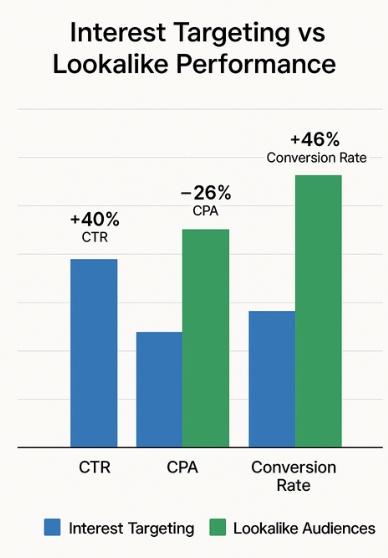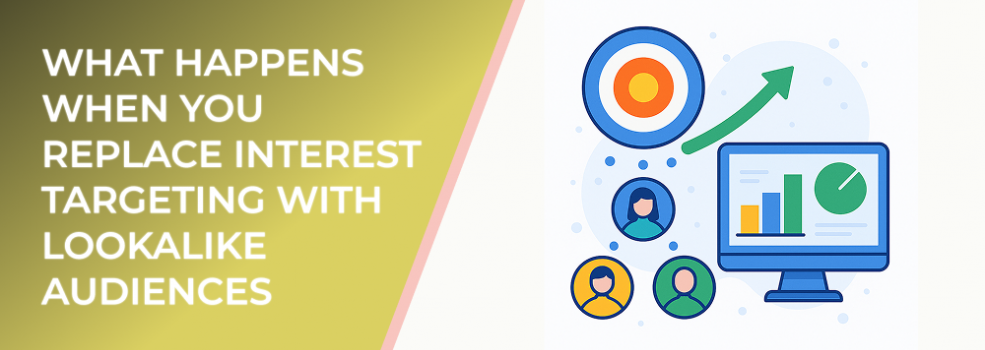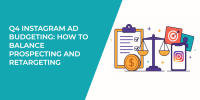Interest targeting relies on user behavior, likes, and activity patterns to determine who sees your ads. While this can be effective for broad awareness, it’s still an educated guess. Facebook’s system interprets user actions, but the signals are not always strong indicators of buying intent.
Lookalike audiences, on the other hand, use actual customer data—from your website visitors, email subscribers, or existing customers—to find people who behave like your best buyers. This shifts targeting from assumptions to data-backed prediction.
According to Meta, advertisers using lookalike audiences see up to 43% lower cost per acquisition (CPA) compared to interest targeting when sourced from high-quality data. The difference grows as your base audience (the seed) becomes more accurate and conversion-focused.
Why Lookalike Audiences Outperform Interest Targeting

Performance comparison: lookalike audiences outperform interest targeting in CPA, CTR, and conversion lift — based on aggregated tests
-
Higher Relevance and Conversion Intent
Lookalike audiences mirror your best customers, which means users are more likely to engage and convert. Instead of showing your ad to people who might be interested, you reach those who have already demonstrated similar buying behavior. -
Better Scalability Without Losing Quality
Interest targeting often burns out quickly—you reach the same users repeatedly, and frequency rises. Lookalike audiences refresh automatically as Meta finds new people matching your seed data profile, allowing sustainable scaling. -
Improved Ad Learning and Optimization
Because the audience signals are stronger, Meta’s algorithm optimizes delivery faster. That leads to better results earlier in the learning phase and more stable performance over time. -
Reduced Audience Overlap and Wasted Spend
When running multiple campaigns, interest-based audiences often overlap, inflating competition within your own ad sets. Lookalikes can be segmented by similarity levels (e.g., 1%, 3%, 5%) to control reach and minimize internal bidding conflicts.
How to Transition From Interest to Lookalike Targeting
-
Start With a High-Quality Seed Audience
Use sources like recent purchasers, high-value customers, or website visitors who added to cart. Avoid small or low-quality datasets—a good rule is to have at least 1,000 qualified users in your seed list. -
Test Multiple Similarity Levels
Create 1%, 2%, and 3% lookalike variations to balance precision and scale. The 1% audience is the closest match to your best customers; higher percentages expand reach while keeping performance steady. -
Combine With Retargeting for Full-Funnel Coverage
While lookalikes work great for prospecting, continue using retargeting ads for warm audiences. This ensures you’re not just finding new people but also re-engaging those already in your funnel. -
Monitor Frequency and CPA Trends
As you scale lookalike audiences, watch how frequency and CPA evolve. A gradual increase in similarity percentage can maintain stable costs while growing volume.
The Results You Can Expect
When advertisers switch from interest to lookalike audiences, they often report:
-
30–50% higher click-through rates (CTR)
-
20–40% lower cost per conversion
-
More stable performance during optimization cycles
These numbers depend heavily on your data quality and ad creative, but the trend is consistent: lookalikes outperform interests across most industries.
Final Thoughts
Interest targeting is not obsolete—it still works for testing creative ideas or broad top-of-funnel awareness. But when it comes to efficiency and ROI, lookalike audiences win. They let you scale smartly, reach higher-quality users, and make Meta’s algorithm work for you, not against you.
If you’re serious about improving ad performance, start feeding Facebook better data and let lookalikes handle the rest.
You may also like:

